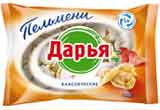 Pelmeni are one of the most ancient of traditional Russian foods and
have born many names through the centuries. Most historians agree that
they originated in Siberia and were probably named by the Komi, a people
indigenous to the Urals. In their native tongue, “pelnyan” means
“dough-ear,” a reference to the food’s half-circular shape. When the
word crossed into Russian, it changed a bit (as most words crossing
language barriers do) to “pelmen,” whose proper plural in Russian is “pelmeni.”
In English they are known most often only in the plural, perhaps because
it is nearly impossible to eat just one of the juicy morsels.
Pelmeni are one of the most ancient of traditional Russian foods and
have born many names through the centuries. Most historians agree that
they originated in Siberia and were probably named by the Komi, a people
indigenous to the Urals. In their native tongue, “pelnyan” means
“dough-ear,” a reference to the food’s half-circular shape. When the
word crossed into Russian, it changed a bit (as most words crossing
language barriers do) to “pelmen,” whose proper plural in Russian is “pelmeni.”
In English they are known most often only in the plural, perhaps because
it is nearly impossible to eat just one of the juicy morsels.
The concept of pelmeni is probably not native to Siberia, however. Early Mongols may have borrowed it from the Chinese and carried it to the Urals and even as far as Eastern Europe. Chinese pot-stickers and east European pirogies are cousins to pelmeni. Italy also borrowed the concept and created ravioli, which, at least in appearance, are pelmeni’s closest relatives.
While the different versions differ fairly widely in their modern forms, the wide geographic area of the food says a lot for its practicality. Pelmeni keep and travel so well that they were also once known as “hunter’s preserved meals.” Pelmeni filling consists of ground beef and pork mixed with minced onion and salt, both natural preservatives for meat. More extravagant versions sometimes include wine (another preservative) or pepper, whose preservative powers are negligible, but which was highly valued before refrigeration for its additive culinary flavor – uniquely suited to masking the taste of slightly turned meat. Onions and salt are, of course, not infallible.
Of course, food in Siberia has a preservative edge, as refrigeration occurs there naturally for many months of the year. Pelmeni are often referred to (by foreigners) as “Siberian Dumplings” or “Siberian Ravioli.” They were and are traditionally made by the hundreds or thousands and kept frozen over time. The process, which is a fairly tedious one of rolling, cutting, filling, folding, and pinching large quantities of dough, is a time-honored family tradition often accompanied by hours of songs, stories, and vodka (what could be more Russian?).
Today, Pelmeni can be bought pre-made in the freezer section of any Russian supermarket. They are a hearty meal that cooks quickly and easily, but most Russians still prefer the tradition of making them by hand, and Russian housewives consider it a question of honor to do so. This unique state-of-affairs has led the frozen supermarket Pelmeni to acquire a modern nickname of their own: “bachelor food.”